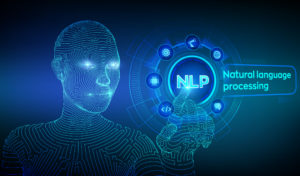Introduction
In Artificial Intelligence (AI), Natural Language Processing (NLP) stands out as a crucial field that bridges the gap between human language and computer understanding. It’s the technology behind chatbots, virtual assistants, language translation tools, sentiment analysis, and much more. But how does NLP work?
Understanding NLP:
1. Language Understanding:
NLP aims to enable computers to understand, interpret, and generate human language in a meaningful way. This involves processing large amounts of textual data and extracting valuable insights from it. Key tasks within NLP include:
- Tokenization: Breaking down text into smaller units such as words, phrases, or sentences.
- Part-of-Speech (POS) Tagging: Assigning grammatical tags to each word in a sentence (e.g., noun, verb, adjective).
- Named Entity Recognition (NER): Identifying and classifying entities mentioned in text, such as people, organizations, locations, etc.
- Syntax Parsing: Analyzing the grammatical structure of sentences to understand relationships between words.
- Semantic Analysis: Extracting the meaning and context from text to comprehend its underlying message.
2. Machine Learning and NLP:
Machine Learning (ML) plays a pivotal role in NLP, enabling computers to learn patterns and structures within language data. Common ML techniques used in NLP include:
- Supervised Learning: Training models on labeled data to perform tasks like sentiment analysis, text classification, and machine translation.
- Unsupervised Learning: Discovering patterns and structures within text data without explicit supervision, used in tasks like clustering and topic modeling.
- Deep Learning: Leveraging neural networks with multiple layers to automatically learn hierarchical representations of text data, enabling more complex tasks such as language generation and machine translation.

3. NLP Applications:
NLP finds applications across various domains, transforming how we interact with technology and analyze textual data:
- Chatbots and Virtual Assistants: NLP powers conversational agents that can understand and respond to user queries in natural language, enhancing customer service and user experience.
- Language Translation: NLP facilitates automatic translation between different languages, breaking down communication barriers and fostering global connectivity.
- Sentiment Analysis: Analyzing the sentiment expressed in textual data to gauge public opinion, customer feedback, and brand reputation.
- Information Extraction: Automatically extracting structured information from unstructured text sources such as news articles, documents, and social media posts.
- Text Summarization: Generating concise summaries of lengthy documents or articles, enabling quick comprehension and information retrieval.
- Question Answering Systems: NLP-powered systems capable of understanding and answering questions posed in natural language, ranging from simple fact-based queries to complex reasoning tasks.
Challenges and Future Directions:
Despite significant advancements, NLP still faces several challenges, including:
- Ambiguity and Context: Language is inherently ambiguous, and understanding context remains a challenging task for NLP systems.
- Data Quality and Bias: NLP models are sensitive to biases present in training data, leading to potential ethical concerns and fairness issues.
- Multimodal Understanding: Integrating information from multiple modalities such as text, images, and audio for more comprehensive language understanding.
Looking ahead, researchers are exploring innovative approaches to address these challenges and unlock new capabilities in NLP. This includes advancements in multimodal learning, better understanding of contextual nuances, and the development of more robust and interpretable models.
Natural Language Processing (NLP) continues to revolutionize how we interact with and analyze textual data, driving innovation across various domains. By combining techniques from linguistics, machine learning, and computational linguistics, NLP enables computers to understand, interpret, and generate human language in increasingly sophisticated ways. As NLP research progresses and technology evolves, we can expect even more transformative applications that further blur the lines between human and machine communication.
If you’re excited about the potential of NLP and how it’s shaping the future of AI, let’s continue the conversation! Join me on Facebook, where I share the latest insights, updates, and discussions on emerging technologies like NLP, machine learning, and more.
